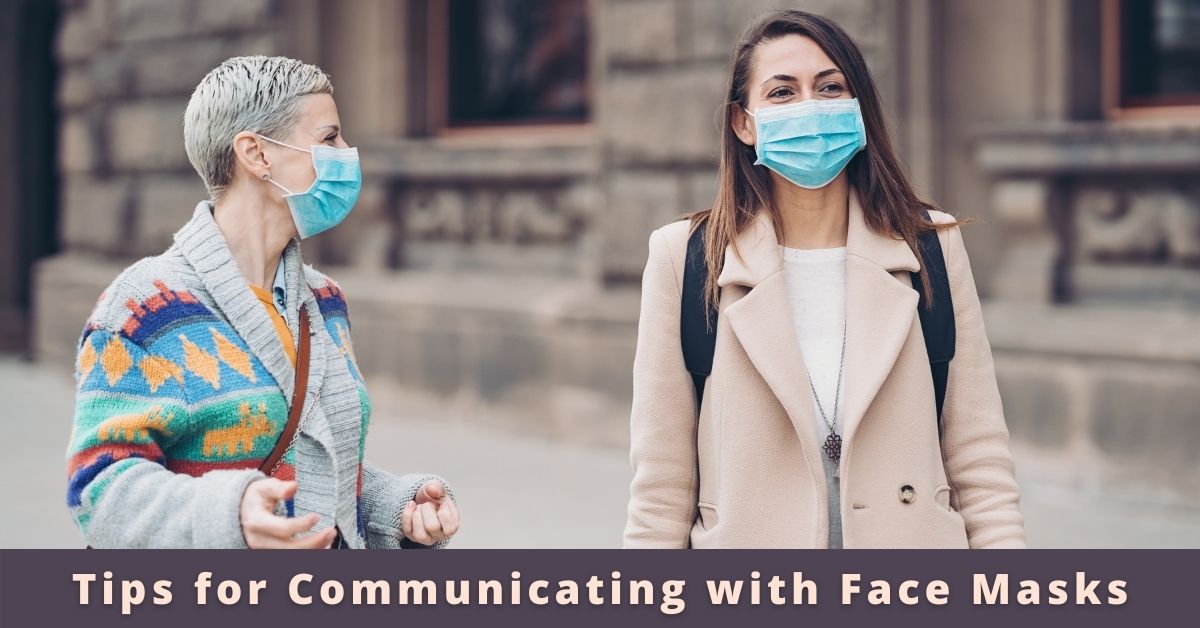
As part of the effort to stop the spread of COVID-19, health officials are asking that we wear face masks. If you have hearing loss, communicating with someone wearing a mask can be a bit challenging, but there are a few things you can do to understand what’s being said. Here are a few tips for communicating with face masks.
Wearing Face Masks Can Make It Harder to Communicate
Wearing face masks helps stop the spread of infections like the COVID-19 virus. However, wearing face masks can sometimes make it harder to communicate. For example:
- Masks block the lower half of the face, making it hard to interpret facial expressions, or read lips.
- Masks can sometimes muffle sounds, making it harder to understand what’s being said.
- Masks can cause people to speak loudly, distorting sounds and making it harder to hear.
- Some masks can be uncomfortable when worn with hearing aids or cochlear implants.
Face masks can make it harder to communicate, but there are ways we can overcome these challenges, and do our part to stop the spread of COVID-19.
Find a New Face Mask
One way to improve communication when wearing a face mask is to find a new face mask. You don’t have to wear a cloth mask that blocks your face. Instead, find a mask with a clear shield over your mouth. Ask your family and friends to get these masks as well. A mask with a clear shield gives you all the protection of a mask, but will let you see more of your friends’ faces so you can all enjoy easier communication.
How to Secure Your Face Mask
If you’re wearing hearing aids or a cochlear implant, a standard mask with ear loops can be uncomfortable. For anyone with a Behind-the-Ear or Receiver-in-Canal hearing aid, the ear loops can get caught in your hearing aids. Here are a few tips for securing your face mask without putting anything behind your ears.
- Use a button extender for your mask. You can attach the mask loops to the extender, and place the extender at the back of your head.
- Find a face mask with four ties instead of ear loops. You can tie up the mask at the back of your head and leave your hearing aids untouched.
- Keep your hearing aids in place using a cloth headband or some wig tape.
Keeping Distant Can Make It Harder to Communicate
Another guideline to stop the spread of COVID-19 is to stay physically distanced from others. When you’re 6 feet away from someone, it can be hard to have a conversation. For example:
- Speech is quieter than usual because it’s coming from further away.
- With this added distance, it can be harder to focus on speech and ignore background sounds.
- Most of the strategies we use to help us hear, like getting closer or leaning in, don’t work when we’re staying physically distant.
- It’s harder to pick up on non-verbal cues or subtle facial expressions.
Tips for Communicating While Distancing
These are some tips to make it easier to communicate while distancing.
- Get their attention. Make sure the person you’re talking to knows you’re talking to them. Get their attention by calling their name or waving.
- Face each other. Always face the person you’re talking to, and make sure there’s nothing blocking your line of sight.
- Talk a little louder. It’s a good idea to raise your voice a little bit so that it carries across the distance. But make sure you don’t yell, since this can distort the sounds and make it hard to understand the words.
- Talk slower. Talking a bit slower will make it easier to follow the conversation. But make sure you don’t drag out the words, since this will make it harder to understand.
- Use body language. When distancing, talk with your hands, and use any other body language to get your point across.
Treating Hearing Loss
If you have untreated hearing loss, communicating with face masks and social distancing can make it even harder to hear. You can improve communication by treating your hearing loss. Contact us to explore your hearing aid options, and learn a few more tips for communicating with face masks.

What Is Sudden Hearing Loss and What Does it Mean?
Matthew Favinger, M.S., F-AAA

Having a Good Time at Weddings With Hearing Loss
Matthew Favinger, M.S., F-AAA

